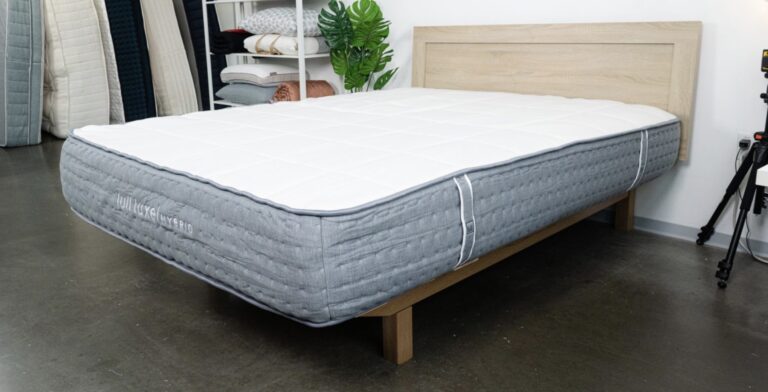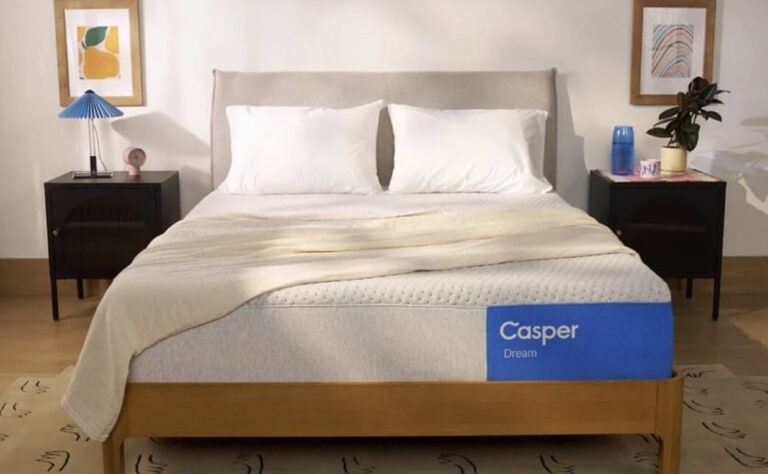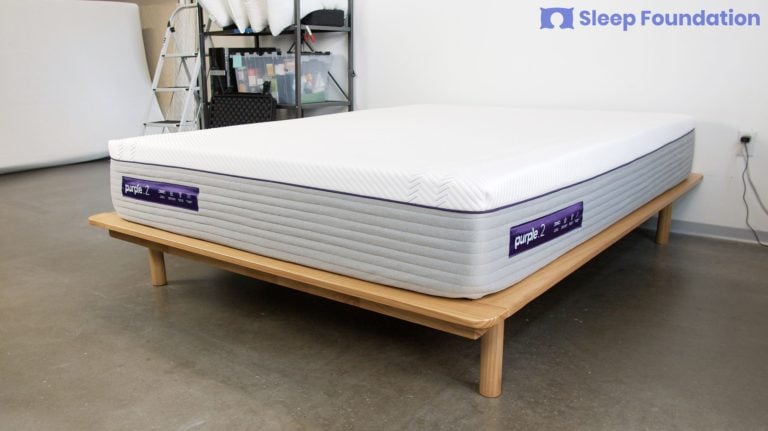When you buy through our links, we may earn a commission. Products or services may be offered by an affiliated entity. Learn more.
Bear vs. Leesa Mattress Comparison
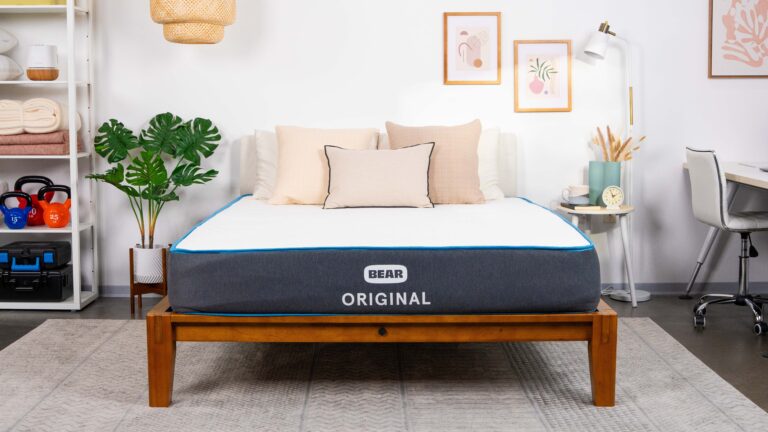
Bear Original
Bottom Line
The ultra-supportive Bear Original offers more support and responsiveness than most competing all-foam models.
35% off + free pillows with code: SF35
Full Mattress ReviewVS
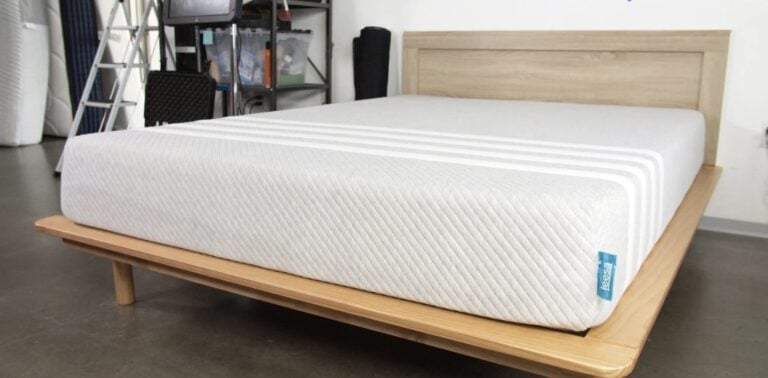
Leesa Original
Bottom Line
The mixed-foam Leesa Original delivers a soothing balance of cushioning, support, bounce, and breathability.
20% off mattresses + 2 free pillows with purchase, 15% off kids’ mattresses, and 20% off bases and bedding
Full Mattress ReviewAs the online mattress industry has grown dramatically in recent years, a handful of brands have grown in prominence and popularity. Two of those companies are Bear and Leesa, which both got started with just one mattress, won over customers, and continued innovating to develop their product lines and establish themselves as leading online mattress companies.
In short, if you’re deciding between Leesa and Bear, you’re likely to end up as a satisfied customer. But finding your ideal mattress among the distinct models of these two brands requires taking a closer look at what each brings to the table.
Each company has multiple mattresses available, and among these beds you’ll find different mattress types, designs, materials, and price points. Our in-depth comparison of Bear versus Leesa begins with the basics about these offerings and then takes a deeper dive into their performance and standout features.
We’ve worked hard to show you which mattresses are the best fit for you. Check out our full mattress guides listed below!
Quick Look
$649 – $1,373
$639 – $2,079
Medium Firm (6), Firm (7)
Medium (5), Medium Firm (6)
- Specialty Celliant cover uses infrared energy to enhance nightly recovery.
- Thoughtful layering of materials provides dynamic performance from all-foam and hybrid options.
- Quality mattress options at affordable prices.
- Blend of contouring and bounce for well-balanced performance.
- Multi-layered comfort systems for improved pressure relief.
- Eco-friendly cover that is made with recycled plastics (Leesa Legend).
- B-Corporation with demonstrated commitment to social causes.
- 120 nights (30-night break-in period)
- Lifetime warranty
- 100 nights (30 night requirement)
- 10 Year, Limited
- A-
- A+
Sizing and Weight Options
Before you buy a mattress, it makes sense to first get a sense of its dimensions. This means taking a careful look at its size, height, and weight.
The mattress size determines how much surface area you’ll have to sleep on. You’ll want a larger bed if you have a bigger body shape, if you like to stretch out, or if you share the bed with another person. In addition, you need to consider the space in your bedroom and what size mattress can fit without being a tight squeeze.
The height of a mattress, especially when considered along with the bed frame, can influence how easy it is to get in and out of bed, which takes on added importance for people who have chronic conditions like arthritis. Mattress height can also dictate whether you need fitted sheets with an extra-deep pocket.
Mattress weight may be an afterthought on most days, but it can be a big deal if you need to move the bed. A heavier mattress may also require that you use a more robust bed frame.
Bear
Leesa
Height
10″Size Options
Twin, Twin XL, Full, Queen, King, California King, Split KingHeight
10″Size Options
Twin, Twin XL, Full, Queen, King, California KingBear Pro
Height
12″Size Options
Twin, Twin XL, Full, Queen, King, California KingHeight
11″Size Options
Twin, Twin XL, Full, Queen, King, California KingHeight
13″Size Options
Twin, Twin XL, Full, Queen, King, California King, Split KingHeight
12″Size Options
Twin XL, Full, Queen, King, California KingStudio by Leesa
Height
10″Size Options
Twin, Twin XL, Full, Queen, King, California KingThe available mattress sizes from Bear and Leesa are nearly identical. The mattresses from the companies are offered in all six standard mattress sizes with only one exception: the Leesa Legend is not available in a Twin.
All of the Bear and Leesa mattresses fall in a height range of 10 to 14 inches, which means they should all work well with fitted sheets that have a standard pocket depth. The tallest mattress is the Bear Star Hybrid, which is two inches taller than the Leesa Sapira Hybrid and two inches taller than the Leesa Legend.
In terms of weight, the all-foam models are quite alike. The Bear Original and Lessa Original, both 10 inches tall, have almost the exact same weight, while the Bear Pro, which is two inches thicker, is about 10 pounds heavier.
Likewise, the hybrid models have comparable weight, all falling between 110 and 119 pounds. The heaviest is the Leesa Legend even though it is one inch shorter than the Bear Star Hybrid.
Given these similarities, sizing isn’t likely to be the deciding factor for shoppers choosing between a Leesa or Bear mattress, but awareness of the available mattress dimensions can still be useful in picking out the optimal bed for your home.
Construction and Materials Comparison
A thorough comparison of the Bear and Leesa mattresses must involve a close look at how they are constructed. The way that a mattress is built, including its materials and how they are layered together, provides some of the strongest evidence for how a mattress will perform and whether it will hold up over the long term.
Some standard terminology is used to describe mattress construction. The support core is at the base of the mattress and is normally its thickest and sturdiest layer. The comfort system encompasses the layer or layers above the support core that shape the characteristics that sleepers most directly perceive, such as contouring and firmness.
In a hybrid mattress, the support core is made with coils, and the comfort system can be made with foam, latex, micro-coils, and/or fabrics like cotton. In an all-foam mattress, the support core is made with polyfoam, and the comfort system is made with foam, latex, and/or fabrics. Both Bear and Leesa include both all-foam and hybrid options in their product lines.
Bear
Bear has three different mattress options. The Bear Original and Bear Pro have all-foam designs, and the Bear Star Hybrid has a coil-based support core.
While the interior construction differs, the cover is the same for all three Bear mattresses, and it is one of the brand’s standout features. The cover is made with a textile called Celliant that has unique properties that allow it to reflect back body heat as infrared energy. By drawing heat away from the skin, this serves the goal of temperature neutrality. In addition, some scientific research has found that the infrared energy generated by a Celliant material can give a boost to the overnight recovery of muscles and other tissue.
The Bear Original was the model that helped give the company its start. It is a 10-inch mattress with a firm (7) feel that has three foam layers underneath the Celliant cover:
- 2 inches of graphite-gel infused memory foam
- 2 inches of transition polyfoam
- 6 inches of base polyfoam
Though its build isn’t complicated, this original offering has won over customers in large part because of the top layer’s ability to soften impact around pressure points and insulate each side of the bed against feeling motion on the other side. The gel infusion works with the cover to decrease heat retention, while the transition and base polyfoam layers prevent most people from pushing too deeply into the bed.
A second all-foam option is the Bear Pro, which is 12 inches tall and composed of four separate internal layers:
- 1 inch of copper-infused polyfoam
- 1.5 inches of gel-infused memory foam
- 2.5 inches of transition polyfoam
- 7 inches of base polyfoam
The top two layers of this mattress work together to provide noticeable conforming despite having a medium firm (6) feel. Copper is naturally antibacterial and its infusion also works to break up heat buildup. The bottom two layers of polyfoam give the mattress a solid feel and allow the top two layers to more effectively accommodate the body.
In contrast to the Bear Original and Bear Pro, the Bear Star Hybrid has an innerspring support core. While Bear doesn’t publish quite as much detail about the Bear Star Hybrid’s construction, we do know that it is made with four layers:
- Copper-infused memory foam
- Transition polyfoam
- Pocketed innerspring coils
- Base polyfoam
The mix of memory foam and polyfoam in the comfort system helps to create a medium firm (6) feel that provides both pressure relief and responsiveness. The memory foam layer deliver great contouring, and the coils generate plenty of bounce. Edge support is improved through a reinforced perimeter in the support core. The Celliant cover, copper-infused memory foam, and coils all chip in to minimize the chances of sleeping hot on the Bear Star Hybrid.
Leesa
Like Bear, Leesa’s product line includes a mix of all-foam and hybrid mattresses. The company’s flagship offering is the Leesa Original, which paved the way for the company’s early success.
The Leesa Original has a soft cover made with a polyester blend. The material is stretchy and about average in terms of moisture-wicking. There are three interior layers under this cover:
- 2 inches of polyfoam
- 2 inches of memory foam
- 6 inches of base polyfoam
The combined 4 inches of foam in the comfort layer create a medium (5) feel. The top layer’s polyfoam has modest contouring and higher responsiveness while the memory foam provides deeper conforming and more limited bounce. The combination creates a well-rounded feel to relieve pressure and isolate motion without excessive sink.
In the Leesa Sapira Hybrid, the cover is made with a cotton blend. Cotton has greater breathability than polyester, allowing this cover to better wick moisture for comfort cooling. On the inside, the Leesa Sapira Hybrid has five layers:
- 1.5 inches of polyfoam
- 1.5 inches of memory foam
- 1 inch of transition polyfoam
- 6 inches of pocketed innerspring coils with reinforced edges
- 1 inch of base polyfoam
This classic hybrid design gives the mattress significant responsiveness. Bounce comes not only from the coils, but also the top polyfoam layer that springs back quite quickly. At the same time, the memory foam helps tailor the bed’s cushioning to meet the body’s weight and facilitate spinal alignment. The polyfoam on either side of the coils generates stability, including around the edge where the coils have already been reinforced.
The Leesa Legend, the company’s luxury mattress, is a hybrid that employs a sophisticated coil-on-coil design. Its cover is made with a blend of polyester, recycled PES, organic cotton, merino wool, rayon, and spandex. The recycled PES is derived from plastics that would otherwise be thrown away, helping to remove an average of around 60 plastic bottles from the environment in each queen mattress. Combined with the other fabrics, this eco-friendly cover is also breathable, stretchy, and soft.
Inside the cover, the Leesa Legend has six layers:
- 1 inch of aerated polyfoam
- 1 inch of memory foam
- 1.5 inches of a mixed-material layer that has micro-coils at the head and foot of the bed and polyfoam in the center
- 1 inch of transition polyfoam
- 6 inches of pocketed innerspring coils with reinforced edges
- 1 inch of transition polyfoam
The coil-on-coil design gives the Leesa Legend plenty of bounce, and the edge support is excellent because of the reinforced perimeter in the support core as well as the creative mixed-material layer in the comfort system. In addition to its responsiveness, the Leesa Legend provides quality pressure relief and motion isolation that come from its memory foam and aerated polyfoam top layers. Its overall comfort feel is medium firm (6), so it provides a comfortable and supportive sleeping surface for the majority of sleepers.
Lastly, the Studio by Leesa is the brand’s newest and most affordable mattress. This all-foam model is very similar to the Leesa Original, and contains three layers inside the cover:
- 1.5 inches of memory foam
- 1.5 inches of transitional polyfoam
- 7 inches of high-density polyfoam
Due to its mixed-foam construction, the Studio by Leesa has contouring yet responsive surface. The mattress is considered medium firm (6).
In-Depth Ratings
A hallmark of savvy shoppers is their ability to cut through the noise and focus on what’s most likely to result in a quality purchase. They are able to identify their priorities, navigate through marketing hype, and zero in on the best fit for their needs.
For mattress shoppers, there are a handful of key elements of design and performance that merit the closest attention:
- Durability: Once a mattress starts to wear out, you can’t count on it to provide pressure relief, bounce, edge support, or other features. On top of that, a durable mattress saves you money by letting you go longer without having to spend on a new bed. Longevity is normally the longest in mattresses that have a robust design and top-end materials.
- Motion Isolation: An important priority for couples, motion isolation is a bed’s ability to prevent movement on one part of the mattress from being felt on other parts of it. This means that if your bed partner tosses and turns, you won’t be woken up by ripple effects of that movement. Memory foam is well-known for its motion isolation properties, and other foam materials can have a strong performance in this area as well.
- Sex: People with an active sex life use their mattresses for more than just sleep, but when it comes to facilitating intimate activity, not all mattresses are created equal. Beds with springiness are more conducive to the type of movements that are typical during sex. On the contrary, deep contouring and limited bounce can be a barrier to some sexual activity because of how they slow down or inhibit movement.
- Temperature Neutrality: A mattress that sustains a consistent temperature through the night can keep you from waking up hot and in a sweat. Most overheating issues are related to a mattress clinging too tightly to the body and not letting the skin breathe. It can also be tied to materials that naturally build up more heat. In general, hybrid mattresses have a better reputation for temperature regulation than all-foam beds, but it’s not uncommon to find specific design elements meant to promote cooler sleep.
- Pressure Relief: Pressure points are the zones of the body that are more inclined to uncomfortable twisting, bending, or impact with the bed. These areas need to be accommodated to prevent waking up with pain. Pressure relief often comes from materials that can tailor their cushioning to mirror the body’s distribution of weight across the surface of the bed. While many types of materials can serve this goal, memory foam is considered by many to be a leader in offering standout pressure relief.
- Off-gassing: It’s normal to notice a light smell when a mattress-in-a-box bed is first unpacked. This smell comes from off-gassing, which is the release of volatile organic compounds (VOCs) created during the production process. VOCs aren’t a health risk, but the smell can be annoying or irritating for some. All-foam models tend to off-gas the most, but the smell usually is gone within a few hours to a few days.
- Ease of Movement: Being able to effortlessly move on a mattress is important to combination sleepers who frequently switch their sleeping position. It’s also meaningful for anyone who wants to avoid the feeling of being “stuck” in a mattress. To maintain ease of movement, a mattress needs to have at least moderate bounce that gives the body a light amount of support as its weight is redistributed into a new position.
- Edge Support: The weak point for many mattresses is around the edge where any softness or deep compression can become exaggerated. If the structural integrity is really low, it may even feel as though the mattress will give out if you sleep or sit near its perimeter. Among the mattress types, hybrids often have above-average edge support while all-foam beds have worse performance.
While perceptions of feel and performance can be subjective, a detailed look at the ratings for the Bear and Leesa mattresses can help guide you to the option that is most likely to match up with what you’re looking for in a new bed.
Bear
Leesa
In-Depth Pricing
For most mattress shoppers, price is one of the most important factors influencing their purchase. Even if you are working with an unrestricted budget, it’s natural to want to get the best value and make the most of your spending.
Many customers wonder why there can be such a wide discrepancy in mattress pricing. While there’s not a simple equation to determine how much a new bed will cost, some central issues have a big role in pricing:
- The type of mattress
- The total height and number of layers
- The materials used in each layer
- The thickness of each layer
- The use of specialty materials, including green or organic components
- The addition of unique design features
- The location where the mattress is produced
The retail pricing for all sizes of the Bear and Leesa mattresses are listed in the following tables, but shoppers should be aware that the listed retail price is not what most customers actually pay. Discounts are common, and it’s usually easy to find a coupon or other promotion if you are shopping online.
Bear
Sleep Foundation Special Offer
35% off + free pillows with code: SF35
Leesa
Sleep Foundation Special Offer
20% off mattresses + 2 free pillows with purchase, 15% off kids’ mattresses, and 20% off bases and bedding
Of all the offerings from Bear and Leesa, the most affordable are (in order) the Studio by Leesa, Bear Original, and Leesa Original. All three of these are solid values for all-foam mattresses, and the Bear Original is particularly economical. The Bear Pro is the most expensive all-foam bed from these two companies, but it is still priced competitively with comparable mattresses on the market.
Among the hybrid models, the Bear StarHybrid is the lowest-priced, and the Leesa Legend is the most expensive. This comes as no surprise since the Leesa Legend is designed as a luxury mattress. For budget shoppers, the Bear Star Hybrid is a compelling option although the Leesa Sapira Hybrid also provides a good return on investment given its overall quality.
Viewed as a whole, Bear tends to win out versus Leesa when it comes to pricing, but the Leesa mattresses are still reasonably priced and provide real value for shoppers who are drawn to the design or features offered by Leesa.
Trials, Warranty, and Delivery
Bear
Sleep Trial & Returns
120 nights (30-night break-in period)
Warranty
Lifetime warranty
Shipping
Free to contiguous U.S.
Leesa
Sleep Trial & Returns
100 nights (30 night requirement)
Warranty
10 Year, Limited
Shipping
Free to all 50 states
Another factor to evaluate when comparing the Bear and Leesa mattresses is their policies for shipping, returns, and warranties. These policies frequently differ for online mattress companies compared to physical stores. As they can affect customer satisfaction and convenience, it’s important to be informed about them before deciding which of these brands is your top pick.
Shipping
For online mattress shopping, free standard shipping is almost always included as part of your purchase. Normally within about 7 days of making your purchase, a large cardboard box will arrive at your door. Inside that box is your mattress, which has been compressed and sealed in plastic. To get it set up, you need to bring the box to your bedroom, remove the mattress, and cut away the plastic so that the bed can begin to retake its complete size. While this installation process is easy, it generally requires two or more people to carry the box and lift the mattress.
With some mattress companies, including both Bear and Leesa, there is an option for in-home setup. This service, known as White Glove delivery, means a team of technicians installs the new mattress in your bedroom and, if needed, removes an existing mattress. This service may not be available in all areas and frequently comes with an extra cost.
Bear Shipping Policies
Customers in the 48 contiguous U.S. states receive free standard shipping for all three Bear mattresses. Mattress-in-a-box shipping to Alaska and Hawaii carries an additional charge.
Bear’s White Glove delivery service is offered in the contiguous United States and costs $100 for installation alone or $150 for installation and removal of an old mattress.
Leesa Shipping Policies
The Leesa mattresses come with free standard shipping to addresses in the 50 U.S. states. Some international shipping, including to Canada, the United Kingdom, and Germany, is available for an extra charge.
White Glove delivery from Leesa includes both mattress setup and old mattress removal. It costs $150 but is not available in all areas.
Sleep Trial and Returns
Many customers are accustomed to lying down on a mattress in a showroom before making their purchase, but online mattress companies take a different approach. Instead of relying on a few minutes in a store to try a mattress, these companies let customers use their bed in their own home with the ability to return it for a full refund if they decide it’s not right for them.
This return policy is known as a sleep trial, and many shoppers find that it’s the most effective test of whether a mattress lives up to their expectations. The standard sleep trial is 100 nights. If the customer asks for a return, the company normally either picks up the mattress or helps find a local site for donation.
Bear Sleep Trial and Return Policy
Bear provides its customers with a 120-night sleep trial. Full refunds are provided to customers who decide to return the mattress, though Bear requires an initial 30-night break-in period. White Glove delivery charges are not refundable.
Leesa Sleep Trial and Return Policy
Leesa has a 100-night sleep trial for its mattresses, and the company asks that you wait for 30 nights before deciding whether to return it. If you want to return the mattress, you will be issued a full refund. White Glove delivery fees are not refundable, and Alaska and Hawaii customers must pay $100 for return shipping.
Warranty
For long-term customer protection, virtually every mattress comes with a warranty that covers defects in materials or workmanship. A mattress warranty does not offer coverage for damage from accidents nor expected wear-and-tear that happens slowly over time.
When looking at a mattress warranty, consider how long it lasts as well as what the company’s obligations are if a defect arises. The best warranties for customers are ones that last for an extended period and require little or no financial commitment from customers to repair or replace a defective product.
Bear Mattress Warranty
Bear provides a lifetime warranty for all mattresses. If a defect occurs, Bear will replace the mattress free of charge.
Leesa Mattress Warranty
For all of their mattresses, Leesa includes a 10-year warranty. During that time, Leesa will repair or replace a mattress with a defect, but the customer has to pay for transportation costs.

Still have questions? Ask our community!
Join our Sleep Care Community — a trusted hub of product specialists, sleep health professionals, and people just like you. Whether you’re searching for the perfect mattress or need expert sleep advice, we’ve got you covered. Get personalized guidance from the experts who know sleep best.

